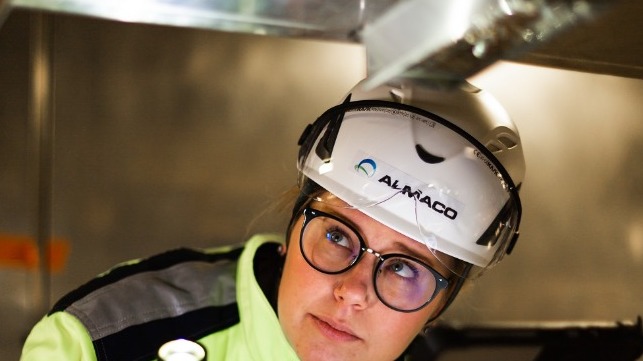Things You Need to Know About Galley Maintenance Plans

[By Nicolas Lesbats, Vice President Maintenance Division at ALMACO]
The importance of having a comprehensive maintenance plan has become commonly recognized in the marine industry. On this, we all agree. The confusion starts when we sit down to pin out what maintenance types to choose from and how to combine them to build a complete plan.
Maintenance comes in many forms: Corrective, Preventative, Condition-based, Predictive, Risk-based, and so on. And to make it even more complicated to get an overview, many of these maintenance types overlap each other. But no worries, they can be roughly divided into two groups, Corrective and Preventative maintenance. Corrective maintenance is fairly simple, “run-to-failure”, and there are not many variations on how the set up a corrective plan. Preventative maintenance, on the other hand, is about anticipation, and this model can be laid out in numerous different ways. Let us dive in for a closer look at the alternatives.
Corrective maintenance
With Corrective maintenance or “run-to-failure”, the strategy is to wait until a failure occurs before reacting. No anticipation. This method is the most commonly used in our and many other industries, for the simple reason that it does not require an organization, processes, management tools, etc.
Corrective maintenance is widely accepted as the best option to minimize short-term maintenance costs. And yes, this method does minimize direct costs, but it also has some disadvantages and indirect costs. For instance, a sudden catering equipment failure can force a restaurant onboard to adapt and reorganize the workflow in the galley to work “around the failure”. This can cause stress and loss of time and efficiency, and it might even force the galley crew to take some dishes off the menu. Ordering new equipment, service or spare parts in a rush is seldom the most economical way to fix a problem in the long run.
Most of the people would answer: “Not really true, we have enough redundancies onboard to avoid that!”. So, we can agree that this is a cost, right? I am used to say, it would be like having twice the amount of cars home in case one is out of service because of no maintenance.
Still, I would say the worst side-effect of choosing Corrective maintenance is the loss of overall performance and lifetime of the equipment. This happens for two reasons.
First, in most cases the equipment must be back in operation as soon as possible. This means the inspection is done quickly, if at all, and only the easily accessible parts are checked superficially. No deep inspection conducted in accordance with professional standards, like measurements, tightening, adjustments, cleaning, lubricating etc., is performed.
The second reason is the lack of training. Without proper technical training, the crew members do not have the knowledge or experience to carry out an accurate inspection. Without proper training or technical documents for support, it is impossible to know whether the results of the measurements are acceptable or not.
Preventative maintenance
Instead of waiting for a failure to happen, Preventative maintenance is designed to anticipate and avoid failure before it happens. There are many ways to do this and the biggest difference lies within deciding when and how to intervene before the failure.
The difference between planned condition-based and time-based maintenance
What we call Planned Condition-based maintenance is the principle of doing interventions every given period of time, based on a mix of OEM recommendations and real use. This method does not use any digital monitoring systems, such as data collection of actual running hours, rotation, etc. It follows a calendar and most likely, intervention happens before the equipment fails.
The main difference between Planned Condition-based maintenance and Corrective maintenance is that during Planned Condition-based maintenance interventions, the equipment is checked in depth, following precise checklists and measurements. The target is to identify the worn-out parts and replace them before they fail.
If we take the Planned Condition-based maintenance concept and add “anticipation” into the equation, we get a concept called Time-based maintenance, in which some equipment are monitored. The most common data to collect from galley equipment are running hours. Like with a car, we can plan to intervene e.g. every 6 months or 1000 hours, whichever comes first. The intervals are irregular, but this method allows higher performance and lower downtime and thereby decreases the risk of equipment failure even further.
True preventive maintenance
Based on the same principles as described in the previous paragraph, the ultimate way to maximize the performance and minimize the downtime of a piece of equipment is to add Preventative maintenance kits to the interventions.
During these interventions, the technicians automatically replace the critical spare parts, whatever their actual condition might be. By “critical spare parts”, we mean the spare parts that lead to a big loss of performance and inevitable downtimes if they fail. These parts are also often selected by the damage chain-reaction that they can initiate. Meaning, due to the failure of a simple and cheap spare part, we end up with numerous damaged parts that lead to a far more expensive repair than just replacing the first part.
Conclusion
None of these maintenance types are right or wrong, they all have their time and place, depending on the equipment we are talking about. Is the equipment unique on the ship? Is it expensive? Does it have a significant impact on the galley workflow? And so on.
As a rule of thumb, one could say that the more expensive, hard to get and crucial for operation a piece of equipment is, the more important it is to have a preventative maintenance strategy.
The success rate of a maintenance plan consists of a good balance between all these maintenance concepts and a proper division of the roles of the crew and external technicians.
The products and services herein described in this press release are not endorsed by The Maritime Executive.
